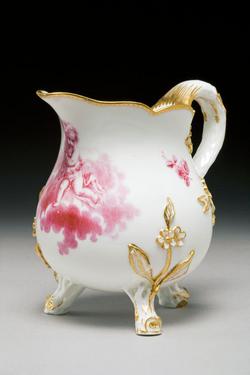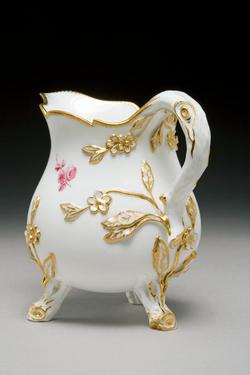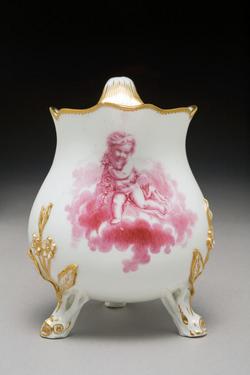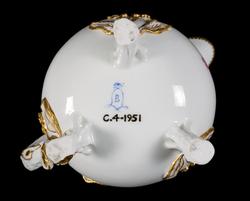Current Location: Gallery 26 (Lower Marlay)
Titles
Pot à lait à trois pieds
Translated as: Milk jug with three feet
Maker(s)
Factory:
Vincennes Porcelain Manufactory
Painter:
Pajou, Augustin
Entities
-
Milk jug
-
Teaware
- Factory name: Pot à lait à pieds ou pot à lait à trois pieds
Categories
Description
Soft-paste porcelain milk jug, with sprays of flowers and leaves in relief, painted in crimson enamel with a putto wearing a garland, and gilded
Soft-paste porcelain, with moulded handle and feet, and applied reliefs, decorated with painting in crimson enamel (camaieu pourpre) and gilding. The jug stands on three crabstock feet. The bulbous body contracts at the neck and then flares upwards and outwards at the front to form a lip; the sides of the rim are notched and slightly everted. The crabstock handle rises from the rim and curves outwards and then downwards and inwards to rejoin the body at the most bulbous point. Sprays of flowers and leaves in relief sprout from the junctions of the handle and legs with the body. Under the lip, painted in crimson monochrome (camaieu pourpre), there is a putto wearing a garland, who sits on a drapery on top of a voluminous cloud. To his right, on the side of the jug, there is a floral spray and to his left, a flying bird holding a branch in its beak. The feet, handle, and relief ornament are outlined in gold, and there is a dentilated gold band round the lip.
Notes
History note: Uncertain before H. E. Backer, London
Legal notes
Given by H.E. Backer
Measurements and weight
Height: 12.1 cm
Acquisition and important dates
Method of acquisition: Given
(1951)
by
Backer, H.E.
Dating
18th Century, Mid
Louis XV
Circa
1754
CE
-
Circa
1755
CE
Note
Augustin Pajou worked at the factory from 1750-60
Rose camaieu, a rather dark pink sometimes approaching crimson or puce in colour, was particularly fashionable from 1752 to 56, appearing on teawares, obects for personal use, and vases. Putti or cherubs after Boucher or in the manner of Boucher, described as 'Enfans camayeux' were one of the most popular types of decoration. An example of the first size with this type of decoration was sold on 28 November 1755 for 30 livres (about 23-25 livres to the £ sterling in mid-18th century).
This form inspired by silver milk jugs was in production at Vincennes by October 1752 when the inventory of the factory's stock mentioned ‘1 petit pot au lait à 3 pieds’ was listed among the biscuit pieces awaiting firing (Ėtat des Pièces de Porcelaines trouvé en Biscuit lors de l’inventaire des Effets remis par Charles Adam à Eloy Brichard le 18 8br 1752 (Bibliothèque de l’Institut de France, MS 5673, p. 1v), A second size was mentioned in the record of a glaze firing on 19 March 1753, and a third size was added in 1756. This is the first size and largest size which ranged between 11.3 and 12.9 cm high. This size was often sold on its own, as opposed to in a set, which was more usual for the smaller sizes.
School or Style
Rococo
People, subjects and objects depicted
Components of the work
Decoration
composed of
enamel
( crimson)
gold
Materials used in production
presumed lead-glaze
Lead-glaze
Soft-paste porcelain
Techniques used in production
Moulding
: Soft-paste porcelain, with moulded handle and feet, decorated with painting in crimson enamel (camaieu pourpre), and gilding
Lead-glazing
Inscription or legends present
Inscription present: interlaced Ls enclosing B
- Location: On base
- Method of creation: Painted in blue enamel
- Type: Factory mark
- Text: an eye
- Location: On base above the factory mark
- Method of creation: Painted in blue enamel
- Type: Painter's mark
References and bibliographic entries
Identification numbers
Accession number: C.4-1951
Primary reference Number: 82565
Stable URI
Audit data
Created: Saturday 6 August 2011
Updated: Thursday 11 August 2016
Last processed: Thursday 14 August 2025
Associated departments & institutions
Owner or interested party:
The Fitzwilliam Museum
Associated department:
Applied Arts

 IIIF Manifest
IIIF Manifest








